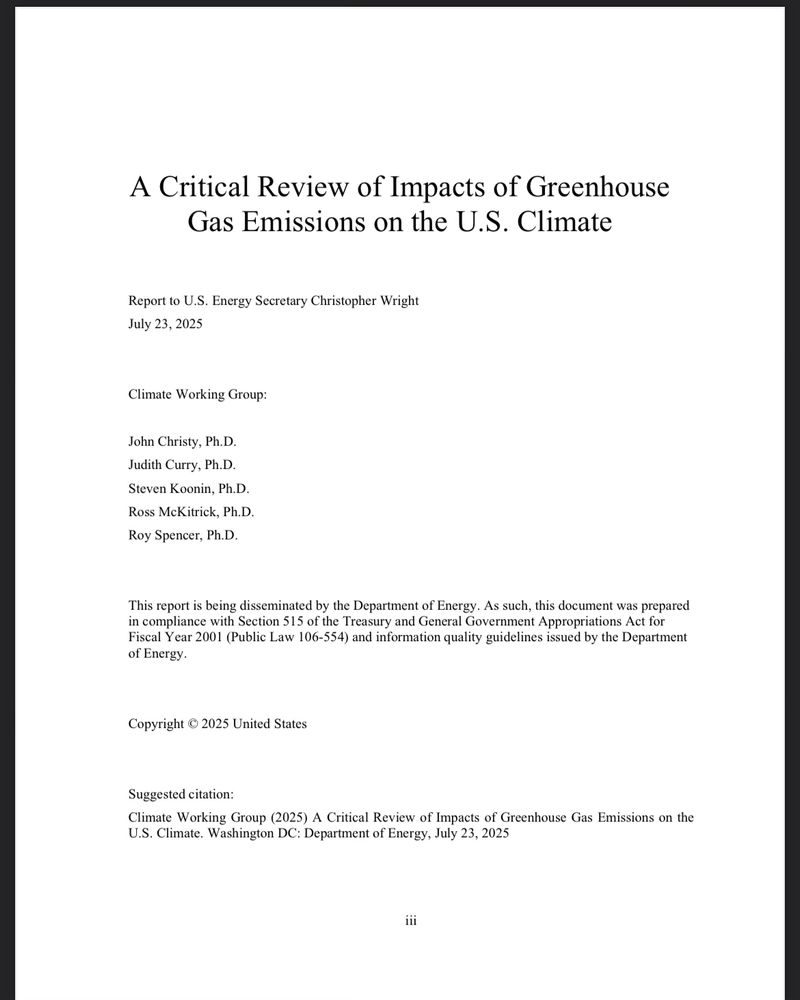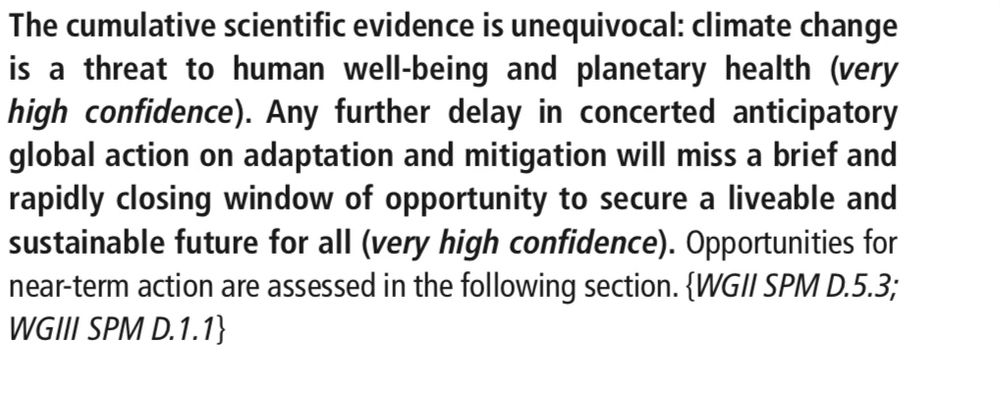Pierre Friedlingstein
@pfriedling.bsky.social
Born at 321 ppm. Climate & Carbon Cycle Scientist. Prof @UniofExeter Directeur de Recherche @CNRS @GlobalCarbonProject
CO₂ emissions are record high

October 18, 2025 at 2:08 PM
CO₂ emissions are record high
That 400 Gt must be coming from a high end scenario (SSP5-8.5?). Not relevant for our discussion where emissions cease or decline rapidly.
IPCC AR6 estimation is 18PgC per degree of warming.
See Box5.1 in AR6 WG1
IPCC AR6 estimation is 18PgC per degree of warming.
See Box5.1 in AR6 WG1

October 18, 2025 at 1:52 PM
That 400 Gt must be coming from a high end scenario (SSP5-8.5?). Not relevant for our discussion where emissions cease or decline rapidly.
IPCC AR6 estimation is 18PgC per degree of warming.
See Box5.1 in AR6 WG1
IPCC AR6 estimation is 18PgC per degree of warming.
See Box5.1 in AR6 WG1
When co2 emissions decline both the land and the ocean sinks decline. See for example sinks in SSP1-2.6 scenarios :

October 18, 2025 at 1:43 PM
When co2 emissions decline both the land and the ocean sinks decline. See for example sinks in SSP1-2.6 scenarios :

July 31, 2025 at 11:12 PM
Indeed but it’s worth mentioning it’s happening for some countries !

May 11, 2025 at 3:00 PM
Indeed but it’s worth mentioning it’s happening for some countries !
Could you indicate where you found this statement in the Emissions Gap Report ?
The exec summary says 1 in 3 chances to exceed 2C by 2050.
The exec summary says 1 in 3 chances to exceed 2C by 2050.

May 2, 2025 at 9:18 AM
Could you indicate where you found this statement in the Emissions Gap Report ?
The exec summary says 1 in 3 chances to exceed 2C by 2050.
The exec summary says 1 in 3 chances to exceed 2C by 2050.
Indeed it’s a massive drop in the land sink. But the same happened in 1983, 1987-88 or in 1998.
See below, land sink estimated as residual of emissions minus atmospheric increase and ocean sink
See below, land sink estimated as residual of emissions minus atmospheric increase and ocean sink

April 15, 2025 at 8:53 AM
Indeed it’s a massive drop in the land sink. But the same happened in 1983, 1987-88 or in 1998.
See below, land sink estimated as residual of emissions minus atmospheric increase and ocean sink
See below, land sink estimated as residual of emissions minus atmospheric increase and ocean sink
The oceans are NOT outgassing CO₂ they still absorb about 25% of anthropogenic CO₂ emissions.

March 30, 2025 at 6:22 PM
The oceans are NOT outgassing CO₂ they still absorb about 25% of anthropogenic CO₂ emissions.
I try to remain a bit more optimistic. Current trajectory is more like SSP2-4.5.

March 26, 2025 at 9:41 AM
I try to remain a bit more optimistic. Current trajectory is more like SSP2-4.5.
Here is a simple 10 years average of the GCB2024 data. Not quite the same …

March 21, 2025 at 5:05 PM
Here is a simple 10 years average of the GCB2024 data. Not quite the same …
Carbon sinks are not turning into sources !

March 9, 2025 at 11:29 PM
Carbon sinks are not turning into sources !
Indeed fossil emissions are actually decelerating. Still increasing but not as fast as 10-20 years ago.

January 20, 2025 at 2:25 PM
Indeed fossil emissions are actually decelerating. Still increasing but not as fast as 10-20 years ago.
Not sure about shipping aérosols but the ocean uptake increased in 2023, as expected during an El Niño.
See last point on figure below.
See last point on figure below.

January 20, 2025 at 8:16 AM
Not sure about shipping aérosols but the ocean uptake increased in 2023, as expected during an El Niño.
See last point on figure below.
See last point on figure below.
2024 was an El Niño (as was 2023). CO₂ growth rate is always higher than average during El Niño (and lower during La Niña).
See figure below, 1987-88, 1997-98, 2015-16, and 2023.
2024 not yet on that plot.
See figure below, 1987-88, 1997-98, 2015-16, and 2023.
2024 not yet on that plot.

January 19, 2025 at 8:47 PM
2024 was an El Niño (as was 2023). CO₂ growth rate is always higher than average during El Niño (and lower during La Niña).
See figure below, 1987-88, 1997-98, 2015-16, and 2023.
2024 not yet on that plot.
See figure below, 1987-88, 1997-98, 2015-16, and 2023.
2024 not yet on that plot.
That’s similar to the current situation we about 50% of anthropogenic CO₂ emissions stays in the atmosphere

January 19, 2025 at 9:52 AM
That’s similar to the current situation we about 50% of anthropogenic CO₂ emissions stays in the atmosphere
No not seriously indeed. Although it’s actually not that bad (I’m not French though 😉).

December 15, 2024 at 4:26 PM
No not seriously indeed. Although it’s actually not that bad (I’m not French though 😉).
And that’s also why the narrative from the WEF is not helpful.
1.5C is still important regardless of domino effects.
1.5C is still important regardless of domino effects.

December 14, 2024 at 8:24 PM
And that’s also why the narrative from the WEF is not helpful.
1.5C is still important regardless of domino effects.
1.5C is still important regardless of domino effects.
Back from one (intense) week at the IPCC scoping meeting.
Fantastic WG 1 team 👏
Fantastic WG 1 team 👏

December 13, 2024 at 6:03 PM
Back from one (intense) week at the IPCC scoping meeting.
Fantastic WG 1 team 👏
Fantastic WG 1 team 👏
Our GCB estimate (average of IPCC and Forster) is 235 GtCO₂ for 1.5C (50% chance).
Given we emit 41 GtCO₂ per year now, that’s a 3.6 GtCO₂ linear decline per year, about a 9% decrease (for next year, year after next would already be 10%, and final year would be 100% 😉).
Given we emit 41 GtCO₂ per year now, that’s a 3.6 GtCO₂ linear decline per year, about a 9% decrease (for next year, year after next would already be 10%, and final year would be 100% 😉).

December 5, 2024 at 3:17 PM
Our GCB estimate (average of IPCC and Forster) is 235 GtCO₂ for 1.5C (50% chance).
Given we emit 41 GtCO₂ per year now, that’s a 3.6 GtCO₂ linear decline per year, about a 9% decrease (for next year, year after next would already be 10%, and final year would be 100% 😉).
Given we emit 41 GtCO₂ per year now, that’s a 3.6 GtCO₂ linear decline per year, about a 9% decrease (for next year, year after next would already be 10%, and final year would be 100% 😉).
But then look at this one, comparing consistent 10 years periods, and you’ll conclude deceleration 😉

December 4, 2024 at 3:18 PM
But then look at this one, comparing consistent 10 years periods, and you’ll conclude deceleration 😉









